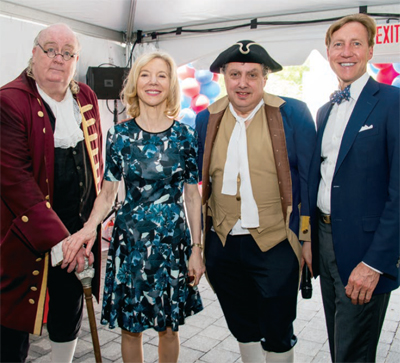
From left: “Benjamin Franklin,” Penn President Amy Gutmann,
“John Morgan,” and Dean J. Larry Jameson.
The main festivities surrounding the 250th anniversary of the founding of the Perelman School of Medicine took place during Medical Alumni Weekend in mid-May. The celebratory year, however, continues for a few more months. In this issue, you’ll find an overview of some of the MAW events and plenty of photographs of alumni, families, faculty members, administrators, and a few celebrities. Our back cover shows the glorious fireworks display over the Philadelphia Museum of Art, where some 1,200 supporters of the Perelman School attended the birthday gala. All in all, it was a time to honor the past and commit to keeping the Perelman School one of the world’s greatest. But I began to notice the presence of a certain historical figure who was threatening to make this issue his own: John Morgan, M.D., whose vision was most responsible for the founding of our medical school.
In “Founders . . . and Feuders,” Dr. Morgan is front and center. In fact, Graham Perry, the designer of Penn Medicine, neatly captured some of Morgan’s occasionally pugnacious personality by placing him squarely in a boxing ring. His opponent: the second professor of the medical school, William Shippen Jr., M.D., who perhaps would be able to use his expertise in anatomy to inflict telling blows. The one-time schoolmates at the Rev. Dr. Samuel Finley’s West Nottingham Academy had shared ideas for the founding of a medical school in Philadelphia. But later Shippen came to believe that he had been left out of the loop.
Morgan reappears in the overview of Medical Alumni Weekend, being one of the topics of a historical panel. Three representatives of institutions and cities where Morgan studied or visited during his stay in Europe provided historical background and suggested how Morgan’s experiences helped shape his vision of a medical school in Philadelphia. Victor A. Ferrari, M.D. ’86, the moderator of the panel, cited Morgan’s remarkable intellectual curiosity, but he also called him “brilliant but flawed,” his stature eventually diminished by an interplay of hubris, politics, and jealousy.
And that’s where I thought the Morgan presence ended – but I was wrong. Who do I glimpse helping to carry the Perelman School’s banner during a parade of alumni on campus (p. 20)? That three-cornered hat, that 18th-century jacket . . . it was indeed Dr. Morgan, or at least a John Morgan impersonator! And who do I find standing proudly beside the familiar figure of Ben Franklin later (p. 35)? Indeed, Dr. Morgan again, haunting the issue!
As we take our leave, here is one last view: Morgan and Franklin in the presence of two other influential Philadelphians.